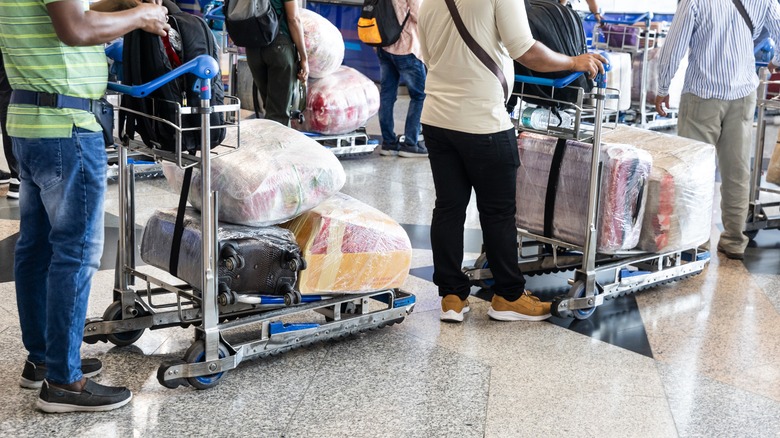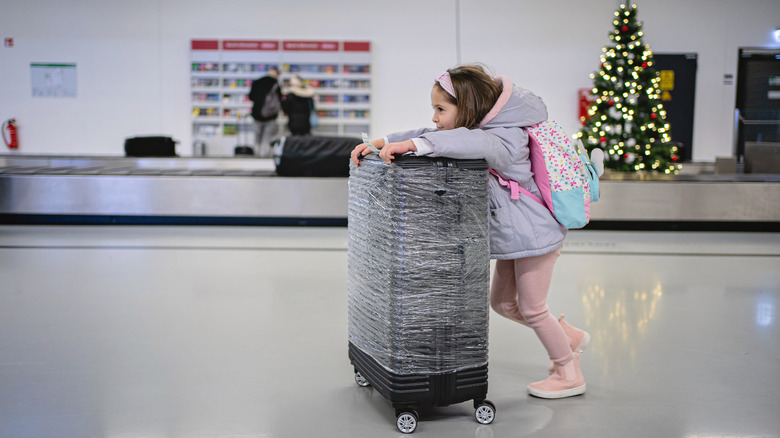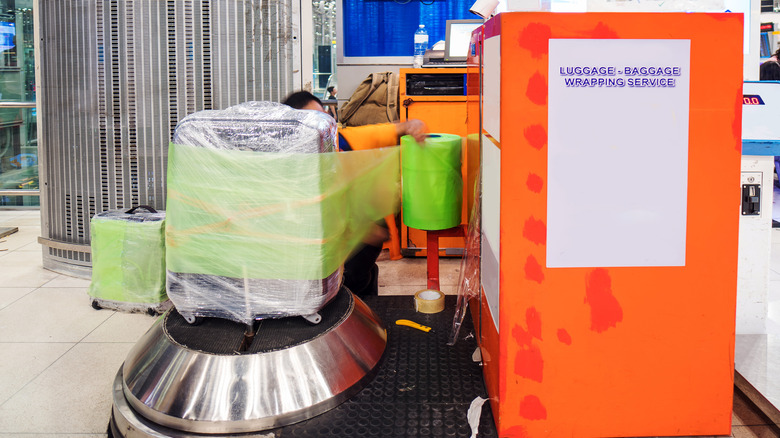One Simple Step Could Help Protect Your Luggage From Theft And Damage While Flying
You may have seen these nifty machines at the airport: Luggage gets placed on a lazy Susan-esque turntable, and then it spins at the speed of light while getting wrapped in layers of plastic. This is luggage wrapping in action. In the hectic world of air travel, the safety and security of your precious cargo is paramount. With approximately 7.6 bags per 1,000 passengers getting mishandled in 2022 (per SITA), is luggage wrapping the simple step that could protect it from damage and theft?
Luggage wrapping is precisely what it sounds like. Before checking in, travelers can wrap their luggage in several layers of plastic film. This service, available at many major airports worldwide, can wrap anything, from unboxed bikes to hardside or softside luggage. The plastic wrap can protect your luggage from scratches and spills.
One of the primary benefits of wrapping your luggage in plastic is its ability to deter theft. Suitcase robbers, who can be other travelers, trespassers, and even airport employees, are most common in airports with lots of traffic, such as JFK in New York or Atlanta's Hartsfield-Jackson. The plastic layer makes it more challenging for them to unzip your suitcase and remove items without drawing attention.
Thieves often target the easiest, most accessible bags. A wrapped suitcase, cumbersome to unwrap without scissors or a sharp knife, is less likely to be tampered with. Moreover, the clear plastic wrap provides no clue as to the bag's contents or the luggage brand, making it a less appealing target.
Benefits of luggage wrapping
Airports are not gentle on luggage. From the moment bags are checked in, they embark on a tumultuous journey through conveyor belts, luggage carts, cargo holds, and the great outdoors with all of nature's elements, often emerging scratched, dented, or worse. According to RewardExpert, some months, like January, are especially notorious for baggage mishaps, while certain airlines, such as SkyWest, ExpressJet, and Envoy, get the worst rankings for mishandled baggage.
Wrapping your luggage can protect it against these perils and help keep it in pristine condition. This is particularly valuable for travelers carrying luxury brand luggage or special items, like sports or accessibility equipment, which are more susceptible to damage. Moreover, a wrapped suitcase stands out on the baggage carousel. In a sea of similar-looking bags, the distinctive look of wrapped luggage can make it easier to spot your belongings, reducing the risk of accidentally picking up someone else's suitcase or, worse, having yours mistakenly taken.
Luggage wrapping also offers peace of mind. Knowing your belongings are securely encased can help you focus more on the journey and less on worrying about the state of your luggage upon arrival. You may be wondering: What about the old lock and key? Isn't that good enough? Unfortunately, no. Skilled and sneaky thieves can easily crack combination luggage locks or cut through soft-shell bags. Valuables should always be kept in your carry-on, and for the extra safety of your checked luggage, the plastic treatment is best.
How luggage wrapping works at the airport
So, how does it work? Usually, wrapping kiosks are located near the departure check-in area. It takes only a few minutes to get your luggage wrapped. With standard suitcases, the wheels and handles are left exposed. The cost of luggage wrapping services depends on several factors, including the airport, the size of the luggage, and the provider of the service. Generally, you can expect to pay anywhere from $15 to $30 per luggage.
Some service providers also offer added perks. Safe Bag offers compensation packages for mishandled luggage, while Seal & Go also offers free baggage weighing. Secure Wrap attaches an individual QR code to each item for tracking and will also do a complimentary rewrap in case TSA unwraps your luggage for additional inspection. Prices can vary between providers based on the type of plastic wrap, extra services, and brand reputation. The cost may also increase for oversized or irregularly shaped luggage that requires additional plastic wrap or more complex wrapping techniques.
While many airports offer professional luggage wrapping services, you can also do it yourself. If you choose the DIY route, ensure you use durable, high-quality plastic wrap and secure all ends tightly. Pay special attention to any handles and wheels, ensuring they remain functional after wrapping. Travelers concerned about the environmental impact can look for biodegradable or recyclable options, like True Star, or invest in reusable luggage protectors made of fabric.


